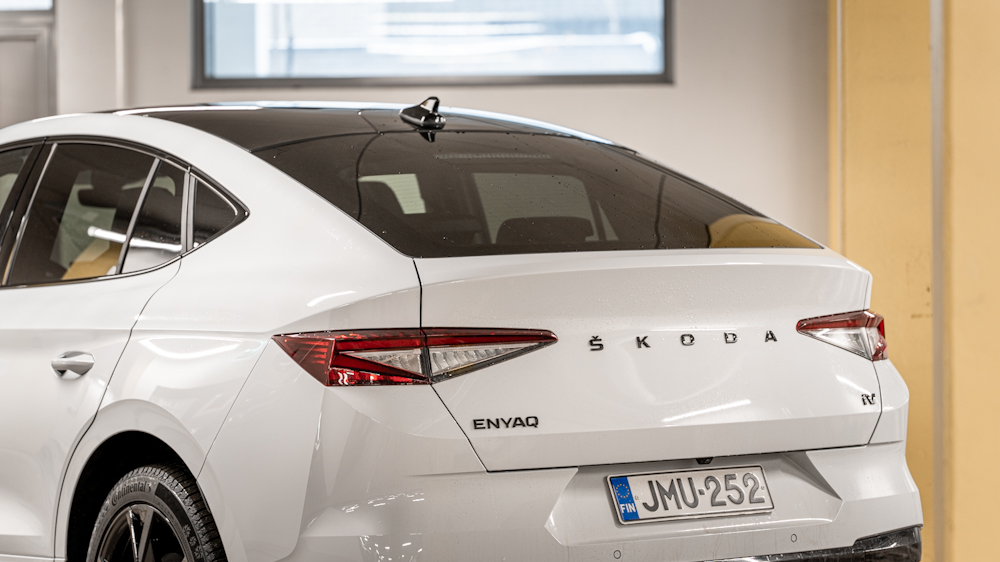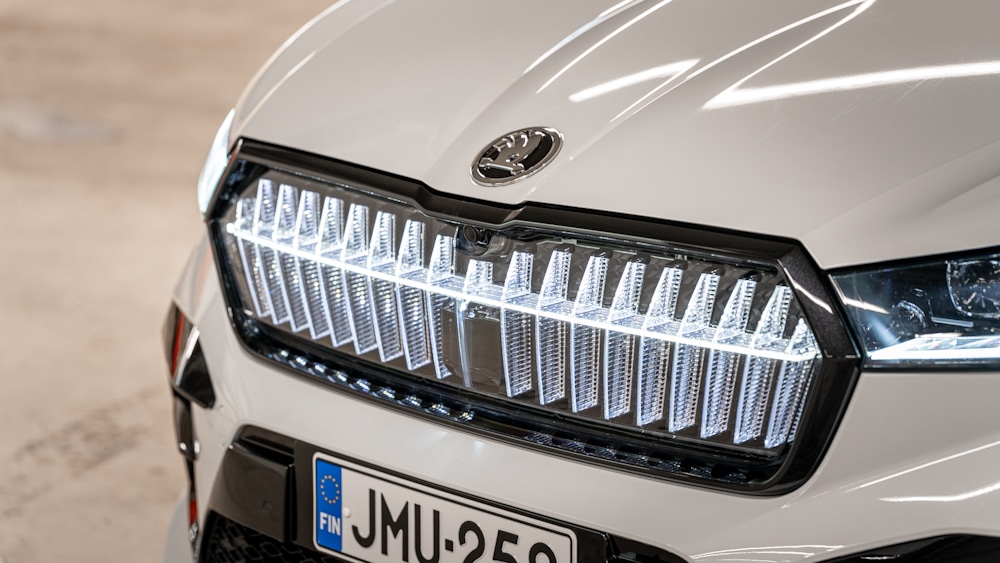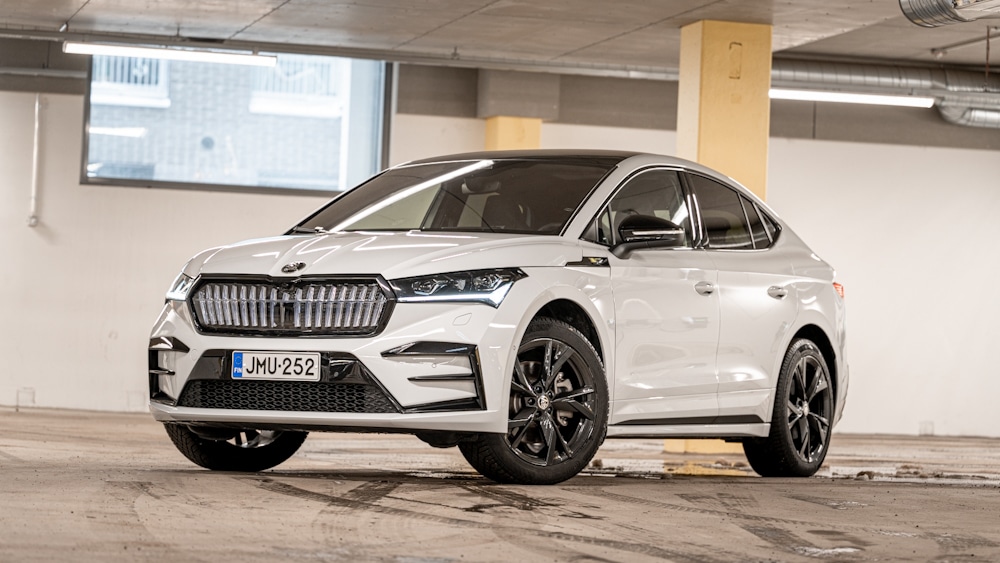In recent years, or should we say in the last decade, Škoda has made a name for itself in Finland with its various models. This is perfectly illustrated by the three consecutive Car of the Year in Finland awards, the most recent of which went to the “basic Enyaq” just over a year ago. The Coupé model in the test drive is the latest edition of the Enyaq.
In the case of the Škoda Enyaq, the RS model designation stands for a sporty model without forgetting practicality. In the world of electrification, power, or kilowatts, is relatively cheap compared with internal combustion engine models. As a result, many all-electric models are either ‘sports cars’ with acceleration of up to four seconds or family cars with little emotional appeal.

The Enyaq Coupé RS goes a bit of its own way in this genre. Outwardly sporty, the 220 kW (299 hp) of the RS won’t make your head stick to the back of your neck when accelerating, but its sporty looks and excellent driveability make it an extremely pleasant everyday car, with enough space for a family of five.
Great to drive
The Enyaq Coupé RS iV is the first all-electric RS model in Škoda’s history. The RS model doesn’t go for power and, compared to Enyaq’s second most powerful model, the Enyaq 80x iV, there are only 25 kilowatts more. In terms of acceleration, this translates into a three-tenths difference, with the RS accelerating from zero to 60 km/h in “just” 6.5 seconds. In terms of acceleration, however, the car can’t be outdone, but the sporty nature of the RS certainly gives the uninitiated a different idea of its acceleration.
When it comes to handling, the RS is a model to be praised. The Enyaq Coupé RS comes with a Sport chassis lowered by 10-15 mm as standard. The Ultra package, selected from the list of options for the test drive and priced at a whopping €5,000, adds an adaptive chassis to the car, among many other options.
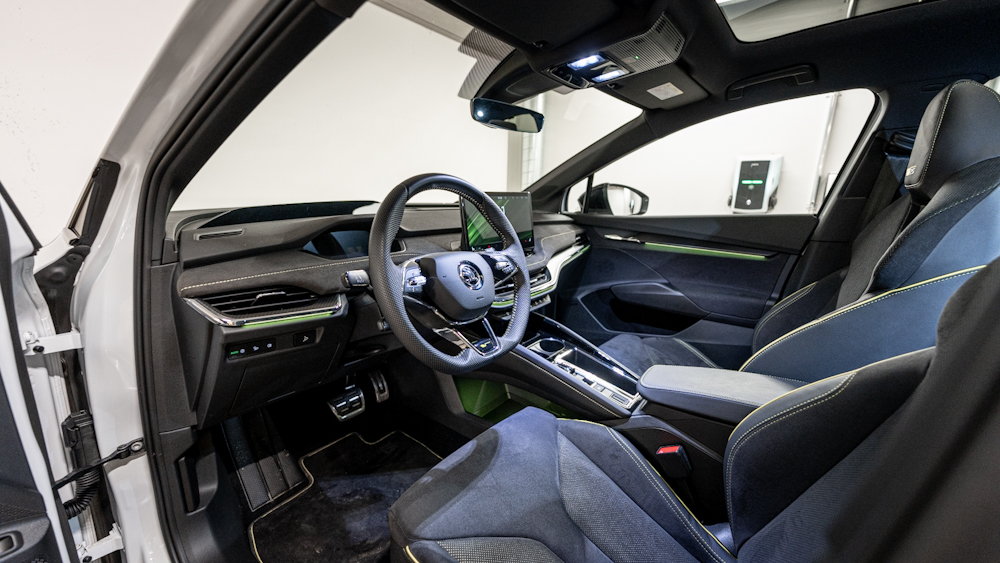
The Enyaq RS with adaptive chassis goes near the top of the range of all-electric cars in this price category in terms of driving experience and quality. A great combination of comfort, feel and agility – just what you’d expect from a sporty family car of this size.
The test drive took place during the zero temperatures of a southern spring-winter, with no shortage of loose snow or slush. Conditions were perfect for testing not only the chassis and ride quality, but also the four-wheel drive and stability control. The winter driving experience could be described as effortless fun, at least when you relax your vigilance on the traction control and traction control. On the road, the ride is stable, at least with 235/50 front and 255/45/20 rear tyres.
Volkswagen MEB chassis
The Enyaq shares the same Volkswagen Group MEB platform technology that underpins the Audi Q4 e-tron and Cupra Born, for example, as well as Volkswagen’s ID models. The Enyaq Coupé stands out from other models of the same platform in terms of looks, but the battery charging curve of the Enyaq cannot be praised extravagantly.
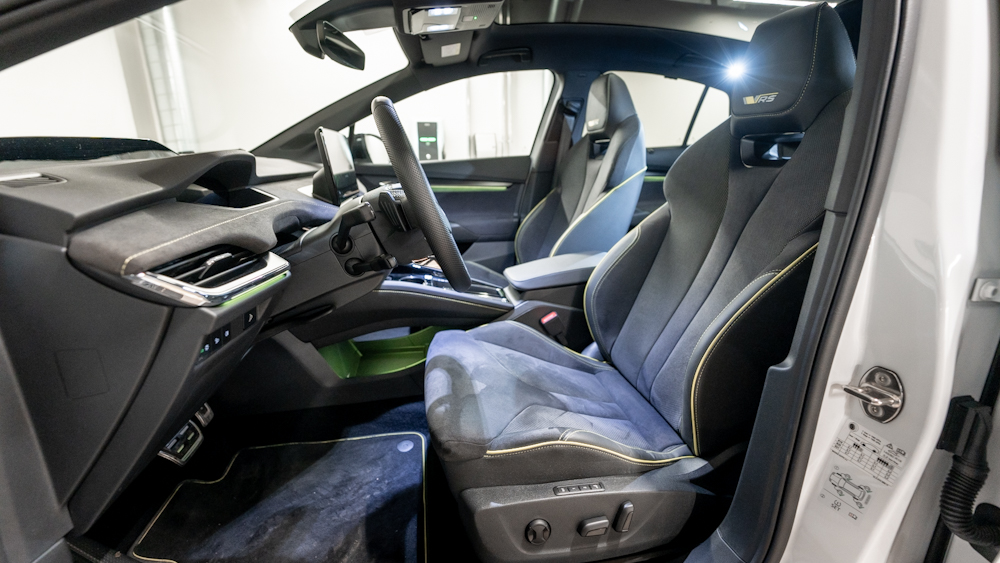
The manufacturer claims a maximum charge rate of 135 kW for the test-driven larger battery size models, with the battery charging from 10% to 80% in less than half an hour at best. Charging speeds were tested with a 150 kW charger and no other deck chargers to load the charger. Charging was started at 11% battery charge, at which point the car appeared to be receiving 68 kW of power. Peak charging current was reached at 22%, at which point only 73 kW of power was being charged.
As expected, the manufacturer’s stated maximum power was not reached, but it was still hoped to see a slightly more rapid power reception. The outside temperature was 2 degrees above zero and the charger was visited after a long drive in a “warm car” at the end of a normal drive.
In the consumption test at an average speed of 100 km/h, the electricity consumption was 21.4 kWh/100km (temperature 1⁰C). During the test drive week, consumption varied between 20 and 24 kWh/100km, and the average consumption over the longer period was 25.2 kWh/100km. The actual range of the car in zero temperatures is around 300-380 km.
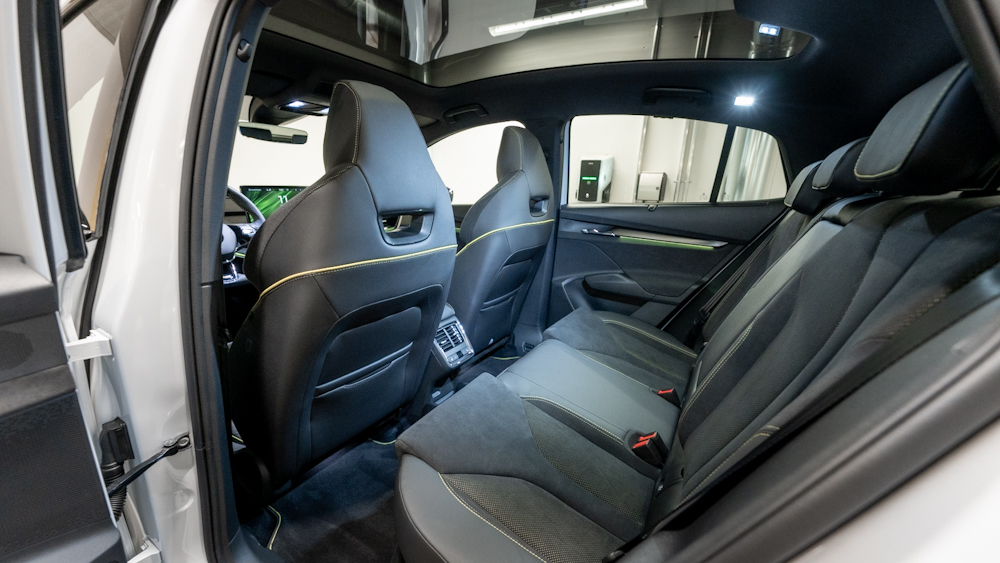
If the car’s charging curve for touring and fast charging doesn’t score full marks, the front seats and soundproofing deserve praise in addition to the good driveability.
The standard lounge interior of the RS we tested is not only good looking, but also has a really good feel to it in terms of materials. In the lounge interior, the seats and dashboard are upholstered in Suedia microfibre fabric, crowned by lime-coloured stitching and detailing in the cabin. Another interior available on the RS model is the leather-trimmed RS Suite for a reasonable price of just over €800.
Passenger comfort and interior sound insulation are also enhanced by laminated sound-insulating glass in the front and rear side windows, which only comes with Sportline and RS trim.
No compromise on space
Known as practical family cars, Škodis have always been competitive in terms of space. Despite the Coupé’s linear design, the Enyaq Coupé offers a reasonable 570 litres of boot space. That’s 20 litres more than in the Volkswagen ID.5. The bigger difference comes when comparing the Enyaq’s non-coupe model and Volkswagen’s ID.4, with as much as 40 litres in the Enyaq’s favour.
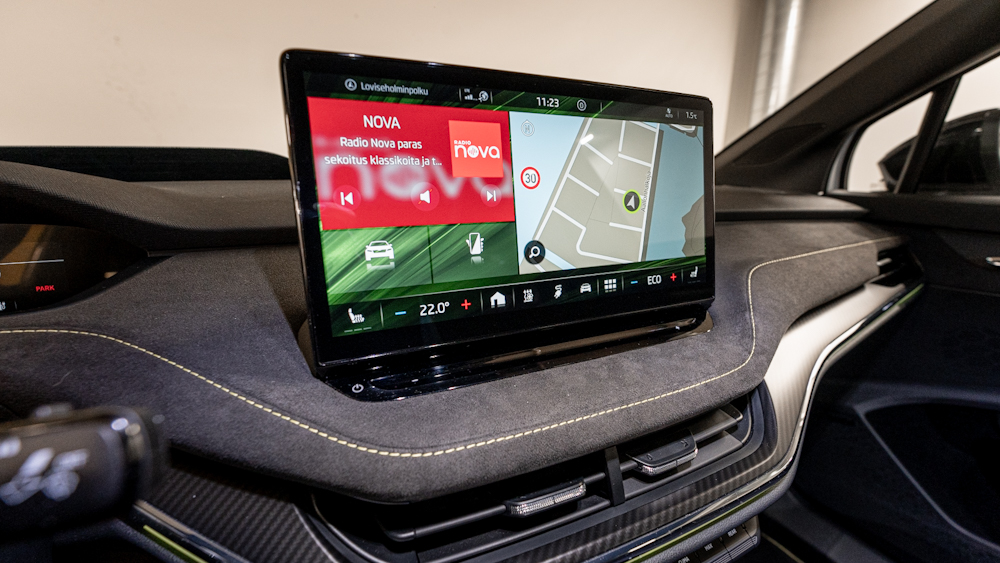
In the back, there’s plenty of room for three people thanks to the flat floor and the large panoramic roof window that always comes standard on the coupé model. The rear seats have two usb-c connectors and a 230-volt socket. There is also a separate temperature control for rear passengers at the back of the elbow rest.
In addition to the RS model, the Enyaq is available with a smaller 62 kWh battery in a coupe and a base version. The smaller battery models are always single-engine and rear-wheel drive, while the larger battery models are available in either rear- or four-wheel drive.
The test-driven RS model is available in coupe and base versions. The base model has a starting price of around €2,000 to €2,500 less than the coupé, regardless of battery size or equipment level.
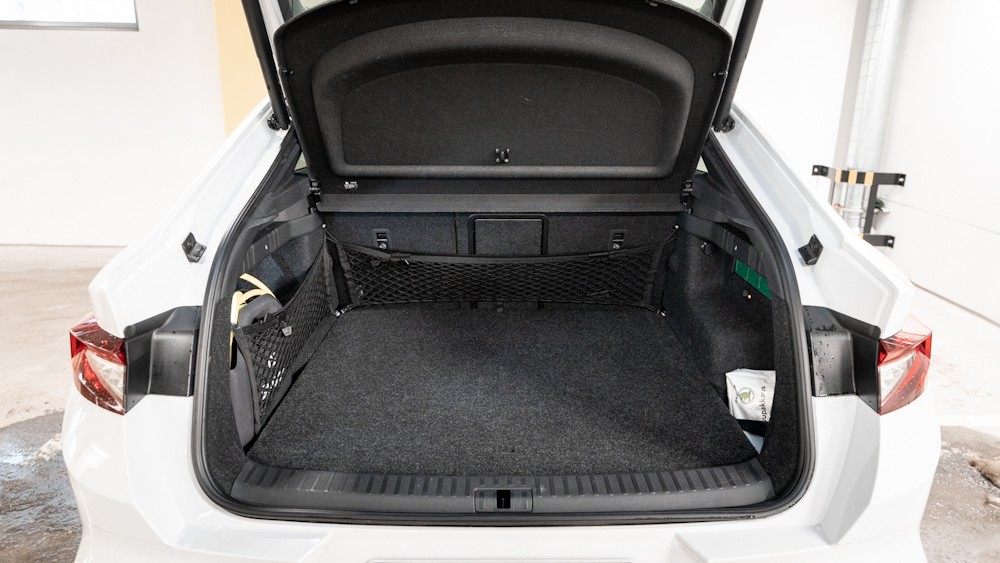
Enyaq’s flagship Coupé RS iV is the most expensive model in the Enyaq range. In terms of drivability, there is nothing to complain about, at least with this model – quite the opposite. Those looking for a more powerful electric car will find other options on the market, but the Enyaq RS offers a quality package that is not just about zero to 60 acceleration.
The price, with a few options, easily tops €70,000, but for many, this will kill the RS dream. Fortunately, there are more affordable options in the Enyaq range, as the car is clearly one of the most successful models in the MEB range.
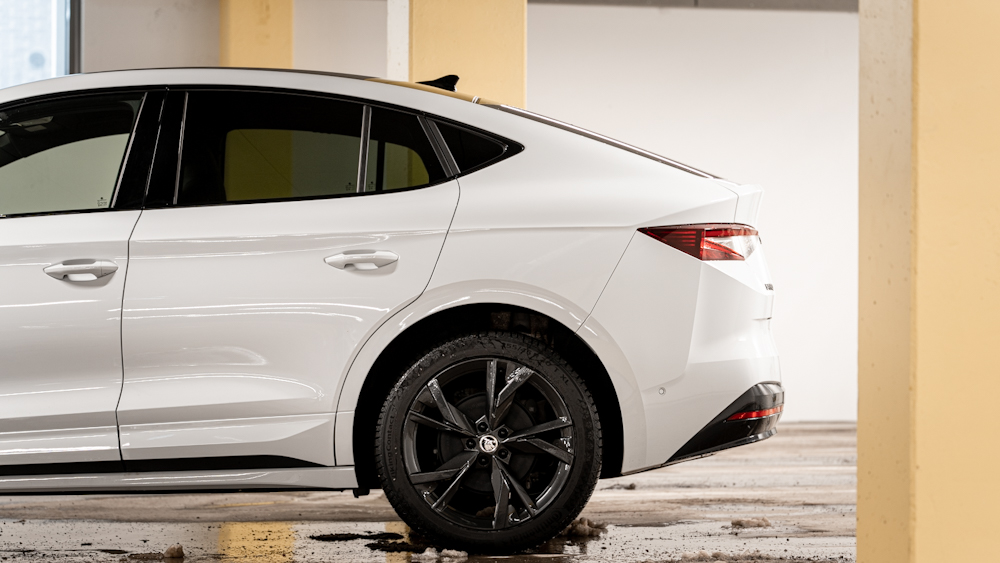
Škoda Enyaq Coupé 80x 4×4 RS iV
- Electric motor power: 220 kW (299 hp)
- Electric motor torque: 460 Nm.
- Acceleration: 6.5 sec. (0-100 km/h)
- Driving battery capacity (gross): 82 kWh.
- Driving battery capacity (net): 77 kWh.
- Manufacturer’s declared combined fuel consumption: 16.8 kWh/100km.
- Manufacturer’s declared range (combined): 520 km (WLTP)
- Consumption during test drive: 20-24 kWh/100km.
- Test-driven range on a single charge: 300-380 km ( 1⁰C)
- Maximum charging power (DC): 135 kW.
- Maximum charging power (AC): 11 kW.
- Dead weight: approx. 2300 kg.
- Cargo space: 570 l.
- Traction: four-wheel drive
- Towing capacity: 1200 kg.
- Starting price: 67 190 euro
- Price for test drive: €75 275
